This article is reproduced from The Archive of the Canadian Lightkeepers Association
Race Rocks
British Columbia
1860
No

This article is reproduced from The Archive of the Canadian Lightkeepers Association
British Columbia
1860
No
Originally in 1860, the light installed at Race Rocks was made up of a tall set of crystal prisms (said to be Lalique crystal from France), designed to carry the beam from an oil or gas-light far out to sea. We do not know why this complete cage was removed but you can see in these historic photos that it was replaced with the current cage sometime in the early 1900’s. An interesting adaptation of the Fresnel lens is noted in this article about using it to focus the suns energy in photovoltaic applications:
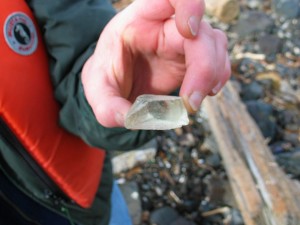 When walking over the cobble areas on the south side beaches at Race Rocks, we often turn up pieces of very thick glass. This one was found in April, 2006.This glass came from the Fresnel lens on the original light installed in 1860, seen here on the right in an artists drawing.[/caption]
When walking over the cobble areas on the south side beaches at Race Rocks, we often turn up pieces of very thick glass. This one was found in April, 2006.This glass came from the Fresnel lens on the original light installed in 1860, seen here on the right in an artists drawing.[/caption]
When walking over the cobble areas on the south side beaches at Race Rocks, we often turn up pieces of very thick glass. This one was found in April, 2006.This glass came from the Fresnel lens on the original light installed in 1860, seen here on the right in an artists drawing
In this report of John Langevin, 1872, The light is referrred to as a “second dioptric light.”The Doty burner was used in lighthouses till the end of the nineteenth century. Note this reference from the 1874 session of parliament where the expense of oil for lighthouses on the West Coast is referred to.
Trev Anderson, 2010–(When they arrived at Race Rocks) “All the equipment for the kerosene light was still there including tanks, pump, and 80mm mantles. The huge weight that was used to drive the clockworks was still connected. I believe the A/C power had just been installed at Race Rocks, as with the station at Lennard Island , and they had turned on the electricity soon after we arrived in 1962. The weight with cable was still used at Lennard Island….(it had to be rewound every two hours…good thing I was ambidextrous) !”
| From CCG reference: “These light stations used colza oil with the Argand burner until it was superseded by the introduction of mineral oils. Colza oil had been cheaper than whale oil, but mineral oil was cheaper than both and its use was extended after the development of a multiple wick burner, invented by a Frenchman, Captain Doty, for the consumption of hydro-carbon oils.” |
You can get a live close-up look of the lucite-lens light beacon above currently operating at Race Rocks by going to the remote control camera 5 .
Click on this slideshow , made on a foggy evening of July 1 2006. Images were taken from the remote camera 5.
GF Photos.
In 1860, the official General Lighthouse Authority for the British Empire was called the Imperial Lighthouse Service . It was responsible for the provision and maintenance of navigational aids in all colonies of the British Empire with the exception of England, Wales, Scotland, the Isle of Man, Ireland, Gibraltar and the Falkland Islands. With the end of the British Empire most of these light houses were taken over by the newly independent countries and the Imperial Lighthouse Service stopped its operations by the late 1970s.
The Imperial Lighthouse of Race Rocks in the Strait of Juan de Fuca was the only stone tower on the Pacific Coast of Canada. It and the smaller brick Imperial Lighthouse at Fisgard Island in Victoria were built as a pair in 1860 after the first Governor of the Vancouver Island, Sir James Douglas petitioning the Imperial Government in Great Britain.
The History of the construction and attempts to have official heritage designation for this Lighthouse are documented in the following files:
Heritage Designation and Protection
Other images of inside the tower and restoration links
The photos below are all copyright of the photographers. They may be used by permission for educational purposes only.
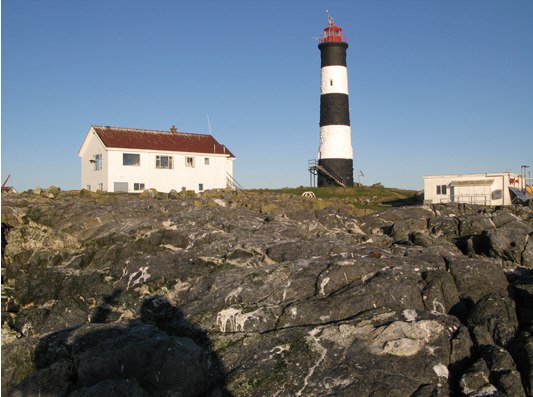
Murray Sager photo. Murray Sager is the relief caretaker of the Race Rocks lighthouse facilities. House, tower and generator building.
This column appeared originally in the Times Colonist
at: http://www.timescolonist.com/travel/Race+Rocks+advisers+push+protection/5275593/story.html
RACE ROCKS ADVISERS PUSH FOR PROTECTION: The Victoria Times Colonist August 18, 2011
After more than a decade of talks, the water around Race Rocks remains without federal protection. Now a push has begun to persuade Fisheries and Oceans to step back and allow Parks Canada to manage the Salish Sea from Race Rocks to Gabriola Passage.
The Race Rocks Advisory Board, a reincarnation of a board which sat between 1999 and 2002, was disbanded in March (2011) and some members have little faith that DFO can push an agreement to create and fund a marine protected area.
Angus Matthews, executive director of Shaw Ocean Discovery Centre in Sidney, who sat on both advisory boards, is fed up with fragmented jurisdictions and the lack of progress. He fears that, if agreement is reached, the proposal could derail when it reaches Ottawa, as happened in 2000.
“Most people are shocked that Race Rocks is not protected,” said Matthews, who is about to look for support from the Discovery Centre’s 17,000 members. “The public expects more from government and the ocean needs more. Race Rocks is the porch-light of the Salish Sea.”
Concerns include negotiations with First Nations, which, unlike the first round, are in secret, and questions about what benefits DFO is willing to bring to the table.
Dan Kukat, president of the Pacific Whale Watch Association, who has sat on both boards, said DFO is doing nothing to better protect Race Rocks. “It will only create more confusion and paperwork and red tape, and it could be detrimental to the area,” he said. “The Canadian taxpayer has paid $273,000 for consultations that have produced very little.”
The hodge-podge of protection now in place for the rocky islets and lighthouse, one nautical mile off the southern tip of Vancouver Island, includes a provincial ecological reserve designation, which covers the land, ***federal ownership of the lighthouse building,*** some fishing closures and a resident eco-guardian paid for by Lester B. Pearson United World College of the Pacific.
It is vital to have a physical presence on the rock, but DFO is not offering to pay for the eco-guardian, said Matthews. He added that DFO seems unwilling to take on other federal department issues, such as Department of National Defense explosions and dumping of ballast water by freighters.
Glen Rasmussen, DFO oceans co-ordinator, said consultations with First Nations have not finished and, once completed, regulations have to be developed. “We are still targeting to have those published and in place by the end of March,” he said. “But we still have some hurdles to go and I’m not saying it’s a done deal at all.”
The advisory group was disbanded because consultations were complete, but a public advisory board will be re-established once the marine protected area becomes a reality, he said.
So far, on the Pacific coast, Endeavour Hydrothermal Vents and Bowie Seamount are designated marine protected areas and Parks Canada, in partnership with the Haida Nation, has designated water around Gwaii Haanas as a national marine conservation area.
Hecate Strait sponge reefs are going through the process to make them marine protected areas and Parks Canada is working on the southern Strait of Georgia as a national marine conservation area. Parks Canada would be interested in expanding to Race Rocks but, for the moment, such a move is probably not practical, said Richard Carson, Parks Canada’s national marine conservation area director.
“The notion of going bigger is appealing and it’s sorely tempting to dream that dream, but we need to be realistic about what we can achieve. “We have to be realistic about how big a bite we can chew,” Carson said.
Once the southern Strait of Georgia national marine conservation area is established, it is possible that expansion around the southern tip of the Island would be considered, Carson said.
Both marine protected areas and national marine conservation areas have the same objectives of marine protection while allowing multiple uses, but have different management styles.
jlavoie@timescolonist.com
© Copyright (c) The Victoria Times Colonist
*** There is some misunderstanding in regards this statement above , since the island and its contents are more likely provincially owned since the Colonial Government transferred ownership to the province when BC entered confederation. Further clarification on this issue is being sought;
Also see DFO announcement on selling off its lighthouses:
GF 2011.
On Dec 26, 2010 we celebrated the 150th anniversary of the lighting of the lamp in the lighthouse at Race Rocks. This lighthouse, on the most southerly tip of the West Coast of Canada, is the only rock-built lighthouse in British Columbia. It has served the people of the West Coast marine community uninterrupted all this time, and still continues as an important lighthouse and foghorn station today . To mark this sesquicentennial year, Lester B. Pearson College, who manages the island and the Ecological Reserve for B.C.Parks, has set up the Race Rocks Endowment Fund dedicated to the on-going sustainable operation of Race Rocks.
The British Colonist July 18,1859: ” The Imperial Treasury had advanced 7000 pounds to construct two lighthouses, a large one on Race Rocks : a smaller one on Fishguard (sic) Island, mouth of Esquimalt Harbor. Half the sum to be paid by British Columbia and Vancouver’s Island: the other half to be borne by the Imperial Government.”
The British Colonist December 27, 1860: “The Race Rocks Light—The beacon on Race Rocks was lighted last evening for the first time. We had not the pleasure of seeing it shine ; but are informed that it was very brilliant, and every way suited to the duty it will henceforth perform.”
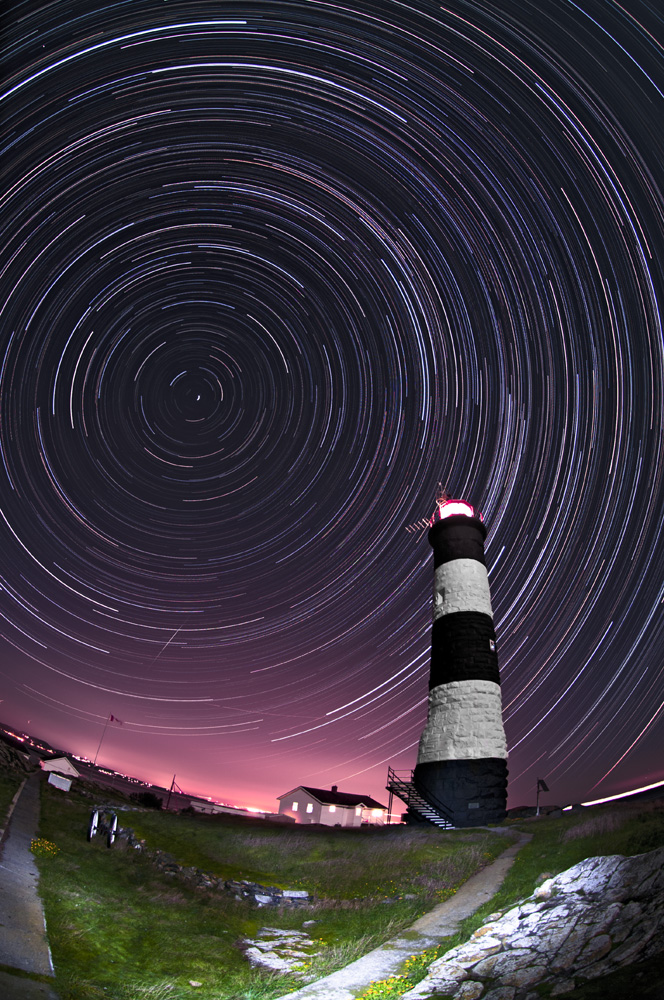 Night time exposure by Ryan Murphy. For this and other images of the lighthouse see this file;
Night time exposure by Ryan Murphy. For this and other images of the lighthouse see this file;
On Dec 26, 2010 we celebrate the 150th anniversary of the lighting of the lamp in the lighthouse at Race Rocks. This lighthouse, on the most southerly tip of the West Coast of Canada, is the only rock-built lighthouse in British Columbia. It has served the people of the West Coast marine community uninterrupted all this time, and still continues as an important lighthouse and foghorn station today .
To mark this sesquicentennial year, Lester B. Pearson College, who manages the island and the Ecological Reserve for B.C.Parks, has set up the Race Rocks Endowment Fund dedicated to the on-going sustainable operation of Race Rocks.
This file has many aspects of the history of the light station.
In the past year as much information as is available has been extracted on the early keepers of Race Rocks and several of the stories of heroism and tragedy are linked here.
Last year the tower underwent an extensive restoration and it now is in excellent condition.
From the top of the lighthouse, Camera1 provides 360 degree coverage of the Eastern entrance to the Strait of Juan de Fuca, from this most southerly point of land on the West Coast of Canada.
Race Rocks Light tower is situated in the Race Rocks Ecological reserve, on an envelope of land on Great Race Rock leased from the Province of British Columbia. Lester B.Pearson College has since the tower and foghorn were automated by the Canadian Coast guard in 1997, provided an Ecoguardian to live on the lightstation and has a long term lease from B.C.Parks for the operation and management of the area.
Garry Fletcher
| See the News Page for news articles about Race Rocks |
| See the Race Rocks History FIle |
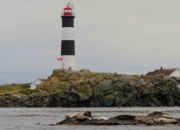 Lighthouse team disputes right to sell Race Rocks operators say beacons not owned by federal government
Lighthouse team disputes right to sell Race Rocks operators say beacons not owned by federal government
BY AMY MINSKY, POSTMEDIA NEWS DECEMBER 24, 2010 
The 150-year-old tower at Race Rocks is among nearly 1,000 lighthouses and light stations under threat.
Photograph by: BRUCE STOTESBURY, Timescolonist.com
OTTAWA — With the federal government preparing to sell almost 1,000 lighthouses across the country, the group overseeing operations at the beacon on Race Rocks, off Vancouver Island, says many are not the government’s to sell.
At issue is who holds the rights to the land — the respective provinces or the federal government.
The lighthouse at Race Rocks, one nautical mile below the southernmost tip of the Island, was built by the Royal Navy in 1860.
It has been listed as “for sale” since June, when the government designated it and the others as surplus property. The tower stands on a rock within an island that is part of a provincial ecological reserve.
While the tower is owned and operated by the Canadian Coast Guard, the land on which it sits is not federal property, a spokesman for the province said Thursday. “The land occupied by the lighthouse on Race Rocks is provincial land, which is under a transfer, or lease, to the federal government for lighthouse purposes,” said Dan Gilmour, a spokesman for B.C.’s environment ministry.
In a letter to the Race Rocks team after the lighthouse was designated surplus property, Gilmour’s colleague, Doug Biffard, said he had received notice from the federal government indicating it was aware of the quandary.
“The Department of Fisheries and Oceans and the coast guard know that they cannot enter into any arrangement to sell, lease or otherwise tenure out, most of the lighthouses in B.C. because the land is under provincial ownership,” the letter said.
Last summer, the federal DFO published a catalogue of 975 surplus properties following the coast guard’s assessment of all the lighthouses it operates.
The list contains at least one from every province except Saskatchewan. To save the lighthouses listed as surplus, a community or group must agree to take on the maintenance of the site, but the federal government would continue to operate and maintain the lighthouse.
The government was criticised when the listing became public in June. Many groups said it undermined the Heritage Lighthouse Protection Act, which had come into force days earlier. The act was designed to ensure the federal government preserved historically significant lighthouses, rather than leave them abandoned.
Those feelings were echoed by the chairman of the Senate committee on fisheries and oceans, Liberal Sen. Bill Rompkey.
This week, the committee released the first of two reports on lighthouses.
When the committee toured the country and hosted discussions on the future of lighthouses, it heard from some of the stakeholders at Race Rocks, including Garry Fletcher, B.C. Parks Ecological reserve warden.
“It would defy logic to see how the federal government could sell a property owned by the province,” Fletcher said.
© Copyright (c) The Victoria Times Colonist
Race Rocks operators say beacons not owned by federal government
Dec 24, 2010
By Amy Minsky, Postmedia News December 24, 2010
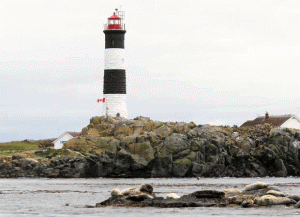 The 150-year-old tower at Race Rocks is among nearly 1,000 lighthouses and light stations under threat.
The 150-year-old tower at Race Rocks is among nearly 1,000 lighthouses and light stations under threat.
Photograph by: Bruce Stotesbury, Timescolonist.com
Ottawa— With the federal government preparing to sell almost 1,000 lighthouses across the country, the group overseeing operations at the beacon on Race Rocks, off Vancouver Island, says many are not the government’s to sell.
At issue is who holds the rights to the land — the respective provinces or the federal government. Continue reading
OTTAWA: The federal government has been preparing to sell almost 1,000 lighthouses peppered across the country.
But many of those beacons aren’t the government’s to sell, says the group overseeing operations on an island in British Columbia where one of those lighthouses sits.
At issue is who holds the rights to the land : the respective provinces or the federal government.
The lighthouse at Race Rocks is located one nautical mile below the southernmost tip of Vancouver Island, and was built by the Royal Navy in 1860.
It has been listed as “for sale” since June, when the government designated it and the others as surplus property.
The light tower which harbours an automated light and a foghorn stands on a small rock within an island that is part of a provincial ecological reserve.
And while the tower itself is owned and operated by the Canadian Coast Guard, the land on which it sits is not federal property, a spokesman for the province said Thursday.
“The land occupied by the lighthouse on Race Rocks is provincial land, which is under a transfer, or lease, to the federal government for lighthouse purposes,” said Dan Gilmour, a spokesman for B.C.’s environment ministry.
In a letter sent to the team at Race Rocks shortly after the lighthouse was designated surplus property, Gilmour’s colleague, Doug Bifffard said he had received notice from the federal government indicating it was aware of the quandary.
“The Department of Fisheries and Oceans and the Coast Guard know that they cannot enter into any arrangement to sell, lease or otherwise tenure out, most of the lighthouses in B.C. because the land is under provincial ownership,” the letter said.
Last summer, the federal Fisheries Department published a catalogue of 975 surplus properties following the coast guard’s assessment of all the lighthouses it operates.
The list contains at least one from every province except Saskatchewan, and includes some iconic structures, such as those at Peggy’s Cove, N.S. and Cape Spear, near St. John’s, N.L.
To save the lighthouses listed as surplus, a community or group must agree to take on the maintenance of the site, but the federal government would continue to operate and maintain the lighthouse, itself.
The government took some heat for the move when the listing became public in June. Many groups said it undermined the Heritage Lighthouse Protection Act, which had come into force days earlier, at the end of May.
The act was designed to ensure the federal government preserved historically significant lighthouses, rather than leaving them abandoned and left to crumble.
Those feelings are being echoed by the chair of the Senate committee on fisheries and oceans, Liberal Senator Bill Rompkey of Newfoundland and Labrador.
“We were disappointed and surprised that the coast guard had made so many lighthouses surplus,” he said. “It really defeats the purpose of the act.”
The committee this week released the first of two reports it is issuing as part of its wide-reaching study of Canadian lighthouses.
The second report, set to be released this spring, will focus on the heritage aspect of the country’s lighthouses, Rompkey said.
One issue the committee will examine closely is how much time a community group has to assume responsibility of any given lighthouse, Rompkey said. As it stands, groups have two years from the day the act came into force.
“We feel they really should revisit that part, at least,” he said.
When the committee was touring the country and hosting discussions on the future of lighthouses, it heard from some of the stakeholders at Race Rock, including Garry Fletcher, BC Parks Ecological reserve warden.
“In my opinion, it would of course, defy logic to see how the federal government could sell a property owned by the province,” he said. “And we conveyed this sentiment when we attended the Senate meetings in Victoria.”
© Copyright (c) Postmedia News
| In preparation for the 150th anniversary of the Race Rocks Lightstation (December 2010) I have come up with a variety of references, about George Nicholas Davies and his wife Rosina. I am entering them here and would urge anyone with further information or photos to get in touch and I would be glad to add them to this historical record. Garry Fletcher |
For some time now, we have had the following entries on our Race Rocks History page about the Davies family: Soon after the light went into service in 1860 it became obvious that the tower was difficult to see by day when approaching from the west. Distinctive black and white stripes were painted on the tower by the first lightkeeper George Davies to improve it’s visibility against the shoreline. These markings remain today maintaining Race Rock’s unique appearance. Although the light was a great improvement on clear nights when it was visible for 18 miles the hazards of Race Rocks were still very real in fog. 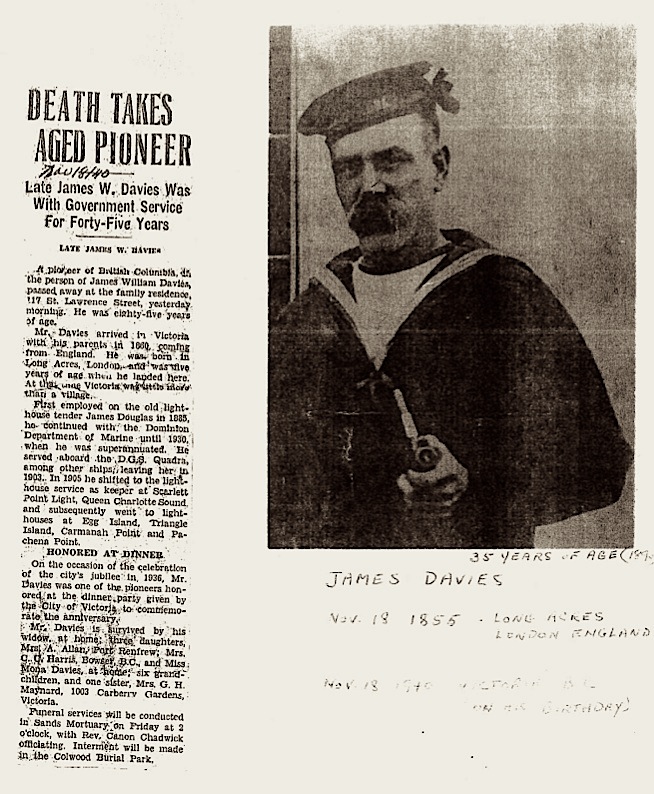 James Davies was 4 years old when the family immigrated to Canada, to live at Race Rocks lighthouse.
Also see https://www.ancestry.com/boards/surnames.davies/998.2
. |
The first keeper’s time at the Race was a very unfortunate one. George Davies and his wife Rosina eagerly awaited the visit of her brother, sister-in-law and three friends on Christmas Day 1865. As the skiff approached with the Davies family watching and waving from the station, a tide rip only 20 feet from the jetty swept the small boat away, capsizing it and dumping the shocked passengers and their Christmas gifts into the water. The station had no boat at this time and each of the unfortunate visitors perished. The new year was no better for the Davies family. During the winter of 1866 George became seriously ill. The Union Jack flew at half mast at the station as a signal of distress for nine days but to no avail. George Davies died at Race Rocks shortly before Christmas 1866.
LIGHTHOUSE DIGEST – July,2002
George Nicholson Davies First Keeper on Canada’s West Coast,
An excellent account of the Davies history by Jeremy D’Entremont . refers to Joy Davies research.
Seaside Memories Tribute to Race Rocks
George Nicholas Davies/light keeper Race Rocks and Fisgard
” Seaside Memories is a tribute to my Great-Great Grandfather George Nicholas Davies. He holds the honour and distinction of being the first full-time lightkeeper at Race Rocks just outside Victoria Harbour. His memory is with me as I watch from our window the waves washing the shore. The light in our guest suites will welcome travellers both Near and Far.
by his Great Great Granddaughter, Wendy Breaks.
http://www.seasidememories.ca/My_Homepage_Files/Page8.html
I am conducting a research project and I’m looking for any images of George Davies – British Columbia’s first lightkeeper. I have checked with the BC Archives and came up with nothing. Does anyone know if there are any photographs or portraits in existence?
Mark Evans – Vancouver, B.C. Canada 1999-10-27
http://www.fogwhistle.ca/bclights/guestbook/index.php?from=0&more=39&key=Davies
George Nicholas Davies/light keeper Race Rocks and Fisgard
Anyone out there have connections to George Nicholas Davies the Lighthouse keeper at Race Rocks and Fisgard lighthouses in British Columbia Canada, or to his son George Nicholas Davies who was a coal miner, Fire Chief and Brewer at Naniamo,B.C. Canada in 1800-early 1900,s ,he died in 1934 and his wife Louisa Jenner died in 1950.? The Davies were supposedly from Wales, some from England, arrived in Canada in 1860.They came with three children-George (just mentioned), James and Rosemary.Their ship sustained damage rounding Cape Horn in rough seas and had to change ships at Hawaii then made their way to Canada to fulfill their lightkeeper contract.More info to share soon.
by Ken Davies, 23 Jul 2000
http://boards.ancestry.com/surnames.davies/257/mb.ashx
Anyone connected to this Welsh fellow who immigrated to Victoria,B.C.Canada from England Aug 1860? Wife Rosina Warner. Children:David,James,George and Mary Elisabeth.
The head of this tribe immigrated here in Aug of 1860 and he was George Nicholas Davies (apparently from Wales),married to Rosina Warner, after his death in about 1866, she later married a Peter Harman. When George and Rosina immigrated from England,they brought their four children over as well, three with them and a child that was ill came later with someone else. Some of the Warner family were here too and there is a very sad story about this family in websites and books for Fisgard and Race Rocks lighthouses on B.C. West Coast, George and Rosina were the 1st lightkeepers over here. One of the books, Keepers of the Light, by Donald Graham, is excellent. Anyway, one of their sons was born in London,LongAcre County, Middlesex,England, possibly more born there.
by Joy Davies 12 Feb 2003
http://boards.ancestry.com/surnames.davies/998/mb.ashx
I am a descendant of George Nicolas Davies through my maternal grandmother’s side. Her father was William Rafter, his mother was Laura Helen Davies, and her father was George N Davies. I am wondering about the information you provided regarding his father George (the lightkeeper) and his wife Rosina? May I ask where I can get a hold of this information? For some reason I had George sr.’s wife penciled in as Elisabeth – I am looking over “George Davis” and “Louisa Jenner”s marriage cert and that is what it says under George’s parents. I would love to clear this up or update my info. Hope to hear from you. Warm Regards,
Joe
by: Joseph Isaac 22 May 2009
http://boards.ancestry.com/surnames.davies/998.1.1/mb.ashx
George Nicholas Davies was the son to the lighthouse keeper George and wife Rosina immigrated to Canada with three sons. Two came with parents, because of health problems the other joined them later. For more information. You can e-mail me jdixie (use the at sign here) shaw.ca
by Kathleen Dixon Mar 2004
http://boards.ancestry.com/surnames.davies/998.1/mb.ashx
George Nicholas Davies/light keeper Race Rocks and Fisgard
1.There is a book out that will give some information about the Davies connection to the lighthouses Victoria BC. ” Keepers of the Light” By Donald Graham.
2. George and Louisa from Nanaimo are my great-grandparents. One of the sons of the first George N (lighthouse keeper)
by Kathleen Dixon 11 Oct 2009
http://boards.ancestry.com/surnames.davies/998.1.1.1/mb.ashx
| Find this article at: http://www.bclocalnews.com/vancouver_island_south/victorianews/community/107075928.html |